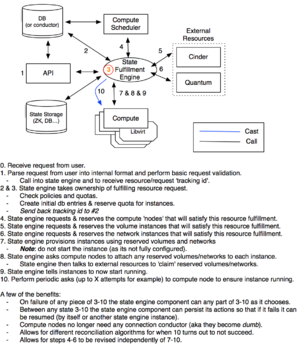StructuredStateManagement
Contents
Summary
Move away from ad-hoc states and state transitions for resource acquisition and modification to a more concrete organized structured state management system in nova.
What problems does this solve in general
- Increases the [stability, extendability, reliability] of the various openstack projects.
- Makes it easier to [debug, test, understand, verify, review] the projects which have a workflow-like concept.
- Removes hard to discover state-transition dependencies and interactions with clearly defined state-transition dependencies and interactions.
- Ensures state transitions are done reliably and correctly by isolating those transitions to a single place/entity.
- Fixes a variety of problems that previously had piecemeal like patches applied to attempt to solve them (avoiding fixing the larger problem).
- Eliminates the inherent fragility of the current ad-hoc workflows that exist in the openstack projects.
- They are by there ad-hoc nature hard to debug, hard to verify, hard to adjust, hard to understand (just hard in general)...
- Makes it possible to audit & track the state transitions performed on a given resource.
- This kind of functionality has started to appear in nova, but the ad-hoc nature was preserved :-(
- Addresses the underlying key point of http://www.slideshare.net/harlowja/nova-states-summit/9 where states will now be fully recovered from on cutting.
What problems does this solve in nova (+ the general ones)
- Removes the need for periodic tasks to cleanup garbage (orphaned instances, orphaned resources...) left by nova's ad-hoc states.
- Creates the path for smart resource scheduling.
- Makes it possible to do [resizing, live migration] in a more secure and manageable manner.
- Discussion about how this can be done correctly require a intermediary to orchestrate this ownership transfer.
- Makes it possible for nova to have multi-stage booting where an instances and its dependent resources are first reserved, the resources configured, the instance configured, and then finally the instance is powered-on (thus completing the instance provisioning process).
Issues that would likely not have happened with a better state management system
- https://blueprints.launchpad.net/nova/+spec/compute-instance-cleanup-service
- https://bugs.launchpad.net/nova/+bug/1050979
- https://bugs.launchpad.net/nova/+bug/1061024
- https://bugs.launchpad.net/nova/+bug/1082414
- ...
Connected blueprints
Connected wikis
https://wiki.openstack.org/wiki/Convection
Requirements
https://etherpad.openstack.org/task-system
Discussions
https://etherpad.openstack.org/the-future-of-orch
Plan of record
Step 1
- Create prototype
- Create library and use said library in nova for run_instance action in nova.
Step 2
- Get feedback on prototype.
- Get feedback from summit session.
- Get more feedback from email list + other interested parties.
Step 3
- Adjust nova prototype as needed from feedback.
- Split nova prototype into small chunks.
- Adjust tests for each small chunks (depending on what it changes).
- Submit chunks into http://review.openstack.org (disabling whole/pieces component until ready to turn on?).
Step 4
- Pick another nova action and refactor it to use design from prototype
- Split this other action (refactored) into small chunks.
- Adjust tests for each small chunks (depending on what it changes).
- Submit chunks into http://review.openstack.org (disabling whole/pieces component until ready to turn on?).
- Repeat
Prototype
https://github.com/Yahoo/NovaOrc

